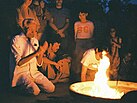Meherabad | |
|---|---|
Pilgrimage Site | |
Meher Baba's Samadhi Mandir and Sanctum Sanctorum at upper Meherabad Dhuni worship at lower Meherabad Dhuni site at lower Meherabad Memorial Tower at lower Meherabad Mandali House at Meherazad Meher Pilgrim Retreat Museum at upper Meherabad | |
| Coordinates: 19°01′46″N 74°43′09″E / 19.029539°N 74.719042°E | |
| Country | India |
| State | Maharashtra |
| District | Ahmednagar |
| Elevation | 672 m (2,205 ft) |
| Time zone | UTC+5:30 (IST) |
| PIN | 414001 |
| Website | ambppct |
Meherabad is a universal spiritual retreat in Arangaon village about 9 kilometres (6 mi), south of Ahmednagar, Maharashtra, India. It is home to Indian Spiritual Master Meher Baba's Samadhi Mandir.[1] Meherabad was originally established as an ashram by Meher Baba in 1923.[2][3][4]
Amartithi is celebrated in Meherabad every year on January 31 commemorating entombment of Meher Baba's physical form on January 31, 1969.[5] The word "Amartithi" was coined by Meher Baba's Mandali and means "deathless day" (Literally, amar, deathless; tithi, day). Also translated as "eternal date" or "date with the Eternal."[6] Around 10,000-20,000 overnight and 30,000-40,000 daytime visitors from all over the world gather at Meherabad for the three-day program.[7]
Amartithi is celebrated by Meher Baba's followers all over the world, including in the United States, Europe, and Australia, and, besides "Silence Day" (July 10, commemorating the commencement of Meher Baba's lifelong silence), "Christmas Day" (December 25), and "Meher Baba's Birthday" (February 25), it is considered among the most significant holidays among followers of Meher Baba.[8]
At Meherabad the climax of the event takes place on Amartithi day itself when the assembled crowd keeps silence for fifteen minutes in honor of the physical passing of Meher Baba at 12:15 p.m. on January 31, 1969. Meher Baba's flag is flown over Meherabad during Amartithi.[9][10]
- ^ Bowker, John (2003). The Concise Oxford Dictionary of World Religions. Online: Oxford University Press. ISBN 9780191727221.
The Baba's tomb at Meherabad is now a centre of pilgrimage. While it has attracted several thousand people in the West since the 1950s, the overwhelming majority of 'Baba lovers' are still to be found in India.
- ^ "Meherabad, A Rural Town in India and Site of the Meher Pilgrim Retreat". 24 October 2015.
- ^ "Guide to Meherabad". ahmednagarlive.in.
- ^ "Film actor Salman Khan at Meher Baba Samadhi Meherabad". 22 November 2014.
- ^ "AVATAR MEHER BABA". www.speakingtree.in.
- ^ "Amartithi 2021".
- ^ "Amartithi – A Magical Three Day Celebration in Meherabad, India". 1 February 2016.
- ^ "On 31 January Meher Baba dropped his body in 1969 so this day is celebrated as Amartithi every year". 2 May 2009.
- ^ "Meher Baba death anniversary: How a boy born in Pune became one of the major spiritual figures of the 20th century". News9live. 31 January 2023.
- ^ "Amartithi". Meher Mount. 26 January 2024.








